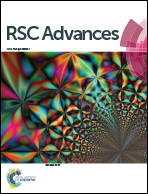Removal of Pb(ii) by nano-titanium oxide investigated by batch, XPS and model techniques
Abstract
Nano-titanium oxide (nano-TiO2) was synthesized and characterized by using XRD, TEM, XPS and FTIR. The effect of contact time, solid content, pH, foreign anions, ionic strength, humic acid (HA) and temperature on the removal of Pb(II) by nano-TiO2 were investigated using a batch technique. The batch results showed that the adsorption of Pb(II) on nano-TiO2 significantly decreased with increasing ionic strength at low pH conditions, whereas the ionic strength-independent adsorption was observed at high pH, indicating that the ion exchange and inner-sphere surface complexation dominated the adsorption of Pb(II) at low and high pH, respectively. The further evidences were provided by the effect of foreign anions and HA. The maximum adsorption capacity of Pb(II) on nano-TiO2 calculated from a Langmuir model at pH 5.0 and 293 K was 30.8 mg g−1, which was significantly higher than commercial P25 TiO2 (15.0 mg g−1). The thermodynamic parameters showed that the adsorption of Pb(II) on nano-TiO2 was an endothermic and spontaneous process. The hydroxyl groups of nano-TiO2 were responsible for the highly effective adsorption of Pb(II) by XPS analyses. Based on surface complexation modeling, a diffuse layer model gave excellent fitting for the pH-edge adsorption data. The results indicated that the nano-TiO2 could be used as a suitable adsorbent for the removal of heavy metals from large volumes of aqueous solutions in environmental cleanup.


 Please wait while we load your content...
Please wait while we load your content...